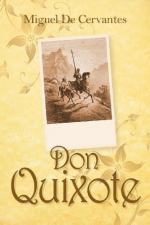|
|
Don Quixote Objects/Places
La Mancha: Don Quijote's home town.
Books of chivalry/knight errantry: Don Quijote was obsessed with these novels and sold off part of his estate to purchase these books for his library.
Helmet: Don Quijote's first helmet is a dilapidated hand-me-down from his grandfather that is destroyed in a fight with a Basque. He later replaces it with a barber's basin that he believes to be the famous Helmet of Mambrino. In Volume 2, Don Quijote speaks of needing another helmet and Samson Carrasco says that he can get hold of a rusty one for him.
Four Books of Amadís of Gaul: These books contain the story of Don Quijote's favorite hero from chivalric tales.
Island: In Volume 1, Don Quijote promises governorship of one to Sancho when Don Quijote becomes an emperor or receives honors and awards for some great deed. In Volume 2, the Duke and Duchess create a mock island and governorship for Sancho.
Suit of Armor: Don Quijote's armor -- that had belonged to his grandfather, which returns home on the back of Sancho's donkey at the end of Volume 1.
Saracen Fierabrás balm: Legendary ointment (named after a giant who swiped some leftover embalming fluid used for Jesus) that cures all knight errant's injuries. Don Quijote whips up a batch in Volume 1 that produces dramatic results in both their digestive tracks.
Mambrino's helmet: Legendary helmet that turns up as barber's basin.
Harness & Bridle: Sancho traded his old one's for barber's (of basin fame) after the barber ran for his life.
Saddlebag: Sancho traded his old one's for barber's (of basin fame) after the barber ran for his life.
Donkey tail: The innkeeper's wife lent this to the priest and barber to use as a beard to disguise barber from Don Quijote. She later becomes obsessed with their returning it to her.
Crate: Don Quijote's friends drag and lock him into one in order to bring him home since he will not return of his own free will and place it upon an ox-cart. During the trip (while Don Quijote wonders why this magical journey does not match with any in his books) it becomes soiled with his urine.
The Inn: The unfortunate inn that Don Quijote and Sancho stay at the most.
The cage: In a story told by the barber from La Mancha, a patient in an insane asylum is kept in one.
The History of that Ingenious Gentleman, Don Quijote de La Mancha: The book by Sidi Hamid Benengeli chronicling Don Quijote and Sancho's adventures. It is referred to constantly in Volume 2, where Don Quijote and Sancho are recognizable, famous figures to the characters in this volume due to people having read the book.
Knight of the Sad Face: Don Quijote's first nickname.
Mirrored Golden Cloak: The Garment Carrasco wore as part of his disguise as the Knight of the Woods/The Mirrored Knight at his first attempt to fight Don Quijote in order to bring him home.
Two huge lions: Caged lions that would rather sleep than fight Don Quijote.
The Knight of the Lions: Don Quijote's new nickname after his anticlimactic run-in with the caged lions.
Montesino's Cave: Don Quijote creates a dream-like adventure here.
Prophetic Monkey: It belongs to the puppeteer (who turns out to be Gines de Pasamonte -- the convict that Don Quijote set free in Volume 1). Don Quijote takes an instant dislike to the monkey and distrusts it.
Puppets: Don Quijote beheads the puppets during the puppet show believing he is rescuing a princess.
Zaragoza: Don Quijote and Sancho were originally headed to this city to enter the jousting tournaments. When Don Quijote learns that Avellaneda lied in his book and said that he had been there already, he deliberately avoids the city to prove him a liar.
Flour Mills: These were on the River Ebro and Don Quijote takes them for a castle city.
Estate: The estate belonging to the Duke and Duchess.
Castle: The castle belonging to the Duke and Duchess.
Clavileño: The wooden flying horse sent by the giant Malumbruno.
Baratario Island: The 'island' that Sancho has waited for so long where he becomes governor.
Three handkerchiefs: These belonged to Altisidora who let Don Quijote keep them. They are valued as a great prize.
Nets of Green Cord: The partiers set these up to catch birds, but caught Don Quijote first.
Bas Relief Carvings of Saints: Sancho refers to this as their gentlest adventure.
Bulls: Despite Don Quijote's admonition for them to stop, they trample him, Sancho, Rocinante and donkey into the ground.
Don Quijote de La Mancha: The Second Part: Avellaneda's untrue sequel about Don Quijote and Sancho's further adventures.
Barcelona: The city in which Don Quijote is defeated by the Knight of the White Moon (Carrasco).
Herd of pigs: After leaving Barcelona, Don Quijote and Sancho are trampled by pigs.
Martyrs: Sancho wonders if it would be easier to become famous saints and martyrs instead of pursuing knight errantry.
Books blown up round like balls with hot air and garbage: Sports equipment from hell. The devils hit these with racquets and they instantly disappear.




